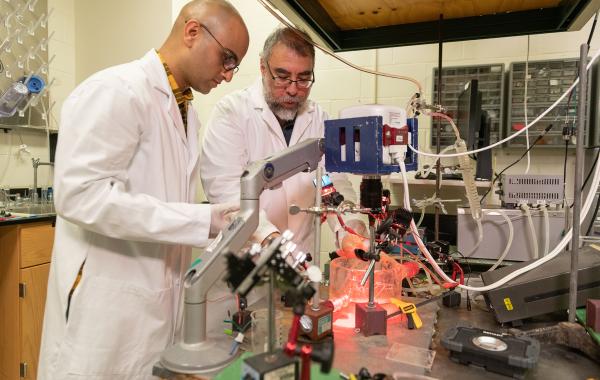The Heart of the Matter

Abouzar Kaboudian and Flavio Fenton
It doesn’t have to be Valentine’s Day for Flavio Fenton to have the heart on his mind. Fenton has been fascinated by the human heart for 30 years. The professor in the School of Physics explores the physics and mathematics behind the heart — specifically, arrythmias, or abnormal heart rhythms.
“When you think about the physics of a heart, the first thing that comes to mind is the pumping action and the forcing of fluids,” he said. “But the reason it contracts is an electrical signal. There’s a lot of physiology and biology behind the function of the heart, but underneath it all, there’s so many areas of physics you can apply to it to understand how it works — and how it fails to work, like in the case of arrhythmias.”
There’s a lot to love about Fenton’s work:
- Last year, Fenton and clinicians at Emory University won the Georgia Clinical and Translational Science Alliance's Team Science Award of Distinction for Early Stage Research for their work using live explanted human hearts to better understand arrhythmias.
- In 2022, Fenton and his collaborators brought a new understanding to complicated heart conditions with the first high-resolution visualizations of stable spiral waves in human ventricles.
- During the Covid-19 pandemic, his research revealed the cardiac risks associated with the proposed use of hydroxychloroquine in treatment.
- The year before, Fenton used graphics processing chips designed for gaming applications and software that runs on ordinary web browsers to move the modeling of deadly heart arrhythmias to less costly computers, and even to high-end smartphones.
- In 2018, Fenton and a team came up with a new imaging technique that could lead to earlier identification of heart rhythm disorders and the development of better treatments.
His current projects involve possible advances in the amount of voltage used to treat fibrillations, and new knowledge about where in the heart to apply that voltage. He maintains collaborations with agencies like the Food and Drug Administration and a wide array of researchers and clinicians, with hopes that hospitals will eventually be able to apply what he has studied over the years to assist in better patient care and health outcomes.
“The heart has been a really fun system to study, and there’s so much that we still don’t know,” he said. “On top of that, it has a main application of directly saving lives if we can find better and safer ways to prevent and terminate arrhythmias.”
